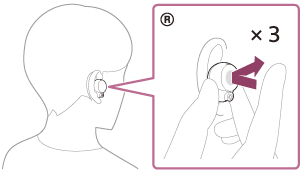Controlling the audio device (Bluetooth connection)
If your Bluetooth device supports the device operating function (compatible protocol: AVRCP), then the following operations are available. The available functions may vary depending on the Bluetooth device, so refer to the operating instructions supplied with the device.
You can use the touch sensor on the right unit to perform the following operations.
- Play/Pause: Tap the touch sensor.

- Skip to the beginning of the next track: Tap the touch sensor twice quickly (with an interval of about 0.3 seconds).

- Skip to the beginning of the previous track (or the current track during playback): Tap the touch sensor 3 times quickly (with an interval of about 0.3 seconds).

When the volume adjustment function has been assigned to the touch sensor using the “Sony | Headphones Connect” app, you can perform the following operations using the headset unit to which the function is assigned.
- Increase the volume: Tap the touch sensor during music playback. The volume increases by 1 step.
- Decrease the volume: Hold your finger to the touch sensor during music playback. The volume decreases continuously. Release your finger from the touch sensor at the desired volume level.
When the volume reaches the maximum or minimum, an alarm sounds.
Note
-
In the factory settings, you cannot adjust the volume on the headset. Adjust the volume on the connected device. If you are unable to adjust the volume on the connected device, install the “Sony | Headphones Connect” smartphone app and adjust the volume in the app.
When you use the “Sony | Headphones Connect” app, you can assign the volume adjustment function on the touch sensor of the headset. - If the communication condition is poor, the Bluetooth device may react incorrectly to the operation on the headset.
- The available functions may vary depending on the connected device, the music software, or app used. In some cases, it may operate differently or may not work even when the operations described above are performed.

